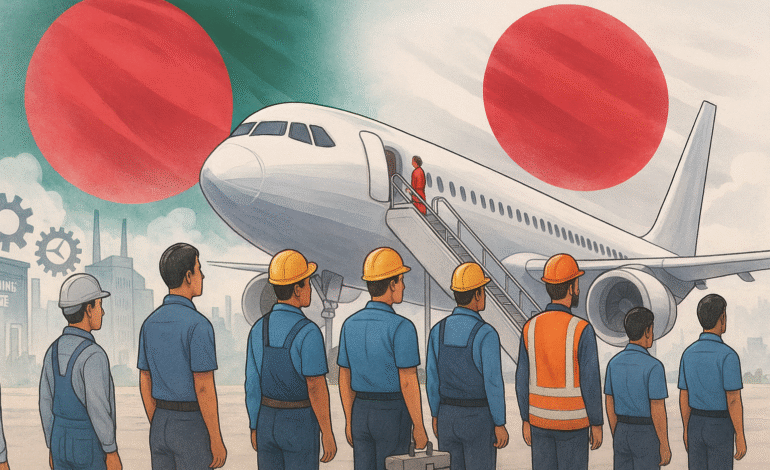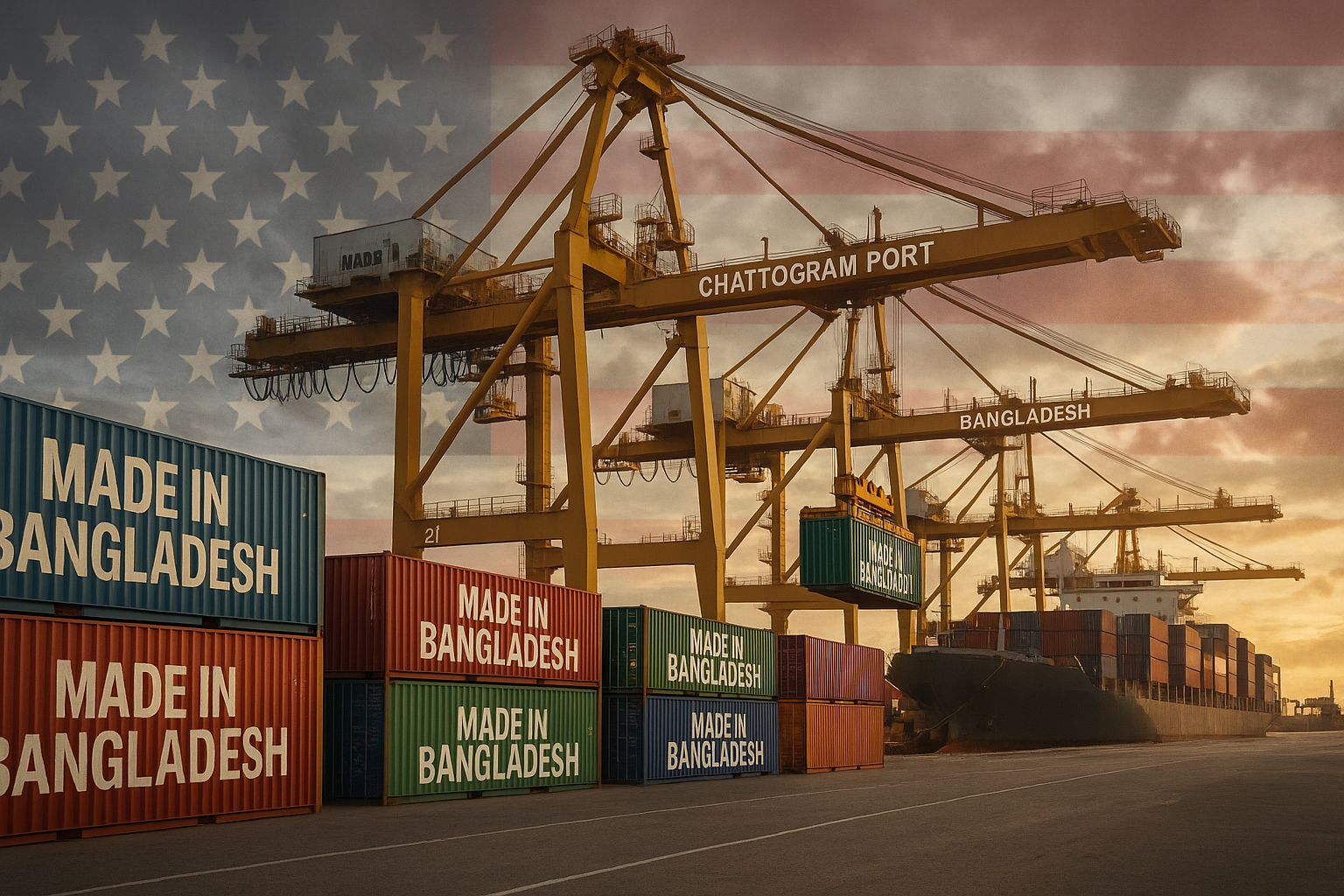Bangladesh Workforce to Japan: A New Era of Global Labour Mobility

Bangladesh Workforce to Japan: A New Era of Global Labour Mobility
Bangladesh is set to supply workers to Japan with implications not just for the two countries, but for global labour markets, skills development and migration policy.
This article explores the context, drivers, opportunities and challenges of the Bangladesh workforce to Japan initiative, drawing on recent developments and global relevance.
Rising Demand in Japan and Bangladesh’s Opportunity
Japan is facing a demographic crisis: an ageing population, declining birth-rate and shrinking workforce. Estimates suggest Japan may require around 11 million foreign workers by 2040. Bangladesh, by contrast, has a large working-age population and a surplus of about 25 million working-age individuals projected.
Thus, the idea of the Bangladesh workforce to Japan is grounded in a classic supply-demand match: a country with labour surplus and another with labour shortage. At a seminar in Tokyo organised by the Bangladesh Embassy and the Japan International Trainee and Skilled Worker Cooperation Organisation (JITCO), officials from both sides emphasised co-operation in deploying skilled Bangladeshi workers to Japan.
From Bangladesh’s perspective, this represents more than just sending workers abroad — it is about tapping into higher-value labour markets, enhancing skills, earning higher remittances, and diversifying migration destinations. For Japan, it offers a chance to plug labour gaps in sectors like manufacturing, agriculture, nursing care and services.
What the “Bangladesh Workforce to Japan” Plan Looks Like
Training, Skills & Strategic Centres
To deliver the Bangladesh workforce to Japan, Bangladesh has taken concrete steps. Among them: setting up 33 Technical Training Centres (TTCs) dedicated to preparing manpower for Japan. In addition, a dedicated “Japan Cell” (or “Japan Desk”) has been established in the Ministry of Expatriates’ Welfare and Overseas Employment to coordinate recruitment, training and deployment.
Agreements & Memoranda
At the Tokyo seminar, Bangladesh and Japan-linked recruiting organisations signed multiple instruments to deepen collaboration. Earlier, Japanese authorities and Bangladeshi counterparts announced plans to recruit 100,000 Bangladeshi workers over the next five years.
Target Sectors and Categories
Japanese labour market pathways relevant to Bangladeshi workers include the Specified Skilled Worker (SSW) category, technical intern training programmes (TITP), and possibly white-collar/engineering roles. For example, needs have been identified in nursing care, manufacturing, driving, ship-building and agriculture.
Why the Initiative Matters Beyond Two Countries
Diversifying Global Migration Flows
Historically, migration from Bangladesh has focused on Middle Eastern and Southeast Asian destinations, primarily for lower-skilled labour. But the Bangladesh workforce to Japan shift reflects a broader global trend: sending countries targeting high-skilled or semi-skilled migration to advanced economies. That means better wages, better protections and more sustainable migration patterns.
Skills Upgradation & Development
For Bangladesh, mobilisation of a workforce to Japan demands investment in technical skills, Japanese language proficiency, cultural orientation and higher standards. That has spill-over effects in domestic training and could raise overall workforce capabilities. This ties into global discussions about the role of migration in human capital development, not just remittance-earning.
Competitive Advantage for Bangladesh
With other countries (e.g., Nepal, Vietnam) already capturing skilled-worker pathways to Japan, Bangladesh’s proactive push means it aims to position itself globally as a trusted supply of quality manpower. For Japanese firms seeking reliable international workers, a well-trained Bangladesh workforce becomes a competitive advantage.
Implications for Remittances, Development & Partnerships
When migration is directed to high-value destinations like Japan, the potential for higher remittance inflows increases, with development implications for Bangladesh’s economy. Moreover, bilateral partnerships that handle labour responsibly can become models for ethical recruitment globally.
Challenges in Executing the “Bangladesh Workforce to Japan” Strategy
Skill & Language Gap
One of the key obstacles is that, despite demand in Japan, Bangladesh has so far lagged behind in sending skilled workers. For example, Bangladesh sent only 3,574 skilled workers to Japan in a recent year, compared to Nepal’s 56,707. Reports point to low Japanese language proficiency, inadequate training curricula and insufficient trainers as major hurdles.
Recruitment Process, Time Delays & Quality Control
Studies show that sending workers to Japan involves complex procedures and may take longer in Bangladesh than in other source countries. Also, ensuring that private recruitment agencies maintain standards and avoid exploitation remains a challenge — globally relevant when discussing safe, orderly migration.
Ensuring Decent Work & Worker Protection
As Bangladesh sends workers to Japan, ensuring that their rights are protected, that they are not exploited, and that conditions meet international labour standards is critical. As the Business Standard has noted, without proper implementation history of migrant exploitation could repeat.
Balancing Quantity & Quality
Japan emphasises quality over quantity — meaning workers must meet required standards rather than simply fill quotas. Bangladesh will need to maintain that balance to avoid reputational damage and ensure long-term sustainability.
What This Means for Potential Migrants and Stakeholders
For Bangladeshi Workers
The Bangladesh workforce to Japan opportunity means access to higher-paying jobs, better working conditions and new skills. But it also means greater requirements: Japanese language competence, technical qualifications, adaptation to different workplace culture, and navigating migration schemes responsibly. Prospective migrants must prepare accordingly, choosing accredited training institutes and registered agencies.
For Bangladesh’s Government & Agencies
The government must support the initiative by increasing capacity at training centres, ensuring language and technical training meets Japanese standards, regulating recruitment agencies, and enhancing bilateral coordination. Monitoring and evaluation systems must ensure transparency and worker protection.
For Japan’s Employers & Recruiting Organisations
Employers in Japan seeking international workers must engage with trusted partners, invest in training and adaptation, and recognise that recruitment from Bangladesh may require up-front support in orientation, language and culture. Further, Japanese firms participating in this initiative benefit from long-term workforce planning and diversification.
For Global Migration Governance
The initiative illustrates how migration policy can evolve beyond low-skilled channels toward more balanced, skills-based flows. It underscores the role of ethical recruitment standards, bilateral labour agreements, and source countries developing pathways for higher-value labour export. As such, it is a case study with relevance to labour-sending and labour-receiving countries globally.
Outlook for the Bangladesh Workforce to Japan Initiative
In the short to medium term, Bangladesh aims to ramp up its workforce exports to Japan. With training centres, dedicated coordination cells and cooperating agencies in place, the foundation has been laid. If executed well, this could result in thousands of Bangladeshi workers entering sectors in Japan in the coming years.
In the longer term, the Bangladesh workforce to Japan model could evolve into a broader framework:
Pathways for Bangladeshi workers into advanced Japanese industries (e.g., IT, engineering, healthcare)
Joint ventures that establish training campuses in Bangladesh aligned with Japanese employer requirements
Bilateral agreements that ensure worker rights, social protection and integration support
Expansion of the model to other advanced countries, building Bangladesh’s reputation as a high-quality manpower exporter
For Bangladesh, success in this initiative could mean not only higher remittances and reduced migration stress, but also an uplift in domestic training ecosystems and workforce quality. For Japan, it addresses a critical structural need: aging population and labour shortage.
Conclusion
The Bangladesh workforce to Japan initiative represents a significant shift in global migration dynamics: source countries like Bangladesh becoming partners in skills-based migration to advanced economies like Japan. It is a story that extends beyond two nations, touching themes of demographic change, skills development, ethical migration, economic opportunity and global labour market realignment.
With the right investments in skills, language, regulation and partnership, this initiative has the potential to be a win-win: improving livelihoods for Bangladeshi workers, delivering much-needed labour to Japan, and contributing to smarter migration policy globally. As the world watches, Bangladesh and Japan may well chart a new model for how countries respond to labour demand, migration flows and workforce development in the 21st century.







